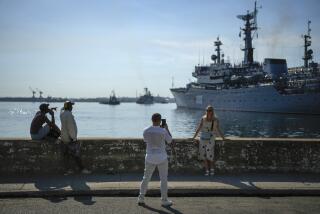Sightseeing buses are a hit in Havana
- Share via
HAVANA — Red and blue double-decker buses have begun bouncing down the potholed streets of Cuba’s capital on sightseeing tours inspired by those in tourist spots such as London and Mexico City.
But instead of Piccadilly Circus, this ride takes visitors past crumbling buildings frozen in the 1950s and lets them gawk at billboards featuring images of Fidel Castro and Ernesto “Che” Guevara that loom over Revolution Plaza. Stops include the Havana Hilton -- which Castro seized and renamed the Havana Libre, or Free Havana hotel, when he took power in 1959 -- and Ernest Hemingway’s favorite watering hole, El Floridita.
Fitting on an island plagued by woeful public transportation, the tourist fleet features just 12 buses, three of them double-decker. Still, Havana residents have begun to hop aboard just to get from place to place, since the tour buses offer some of the few direct rides from downtown to public beaches east of Havana.
“It gives you a good overview of the city,” Argentine tourists Karina and Carlos Oxandaburu said almost in unison aboard the upper deck of a bus on a recent Saturday.
They were looking forward to touring Revolution Plaza, a sprawling square of concrete where Fidel Castro and his brother Raul have offices. The towering Guevara sculpture is affixed to an Interior Ministry building nearby.
Stenciled with the English phrase “Hop on! Hop off!” the tour buses cover 95 miles along three routes. One leaves the plaza and heads to the historic district, stopping at La Floridita and the nearby Capitolio, a replica of the U.S. Capitol that’s slightly taller than Washington’s version.
Another route goes down the beach-front Malecon boulevard. The third leaves from Central Park and ends at Santa Maria, a beach east of the city.
All three double-decker buses ply the Malecon. Two were special orders from China and the other is on loan from the beach resort of Varadero, 90 miles east of Havana.
Gretel Gomez, commercial director for the state-run concern that handles transportation for tourists, said officials plan to add more double-decker buses by the end of the year.
More than 2 million visitors come to Cuba a year, even though Washington’s trade embargo prohibits visits by U.S. tourists.
Gomez said more than 20,000 people have ridden tour buses since they began running May 6.
She said officials first proposed double-decker buses for Havana in 2002, but tabled the plan because public transportation was so spotty that snazzy tour buses might have been seen as an insult by Cubans.
Problems persist, but the government is spending $2 billion to import 3,000 accordion-style buses from China.
“We had to wait until transportation got better,” Gomez said.
Tour bus tickets cost 5 convertible pesos, about $6, and allow riders to get on and off at 44 stops. That’s a lot of ground for not a lot of money, so much so that some Cubans who live east of the city have begun climbing aboard as if they were normal buses.
“Every day it’s more Cubans,” tour bus driver Ernesto Gay said.
Still, almost everyone in Cuba works for the government, and the average state salary is $19.50 per month, meaning the trip is a luxury for many.
“It’s ideal for getting to know the city,” said Edelma Rodriguez, 54, who was riding a tour bus during a recent visit from her home in Matanzas province. “It’s a little expensive for Cubans, but once a year you can afford to have this kind of fun.”
More to Read
Sign up for The Wild
We’ll help you find the best places to hike, bike and run, as well as the perfect silent spots for meditation and yoga.
You may occasionally receive promotional content from the Los Angeles Times.






